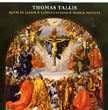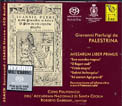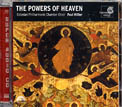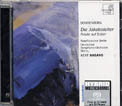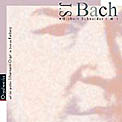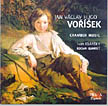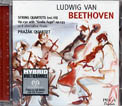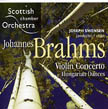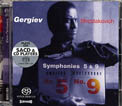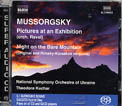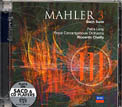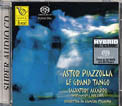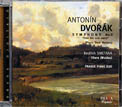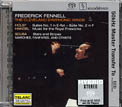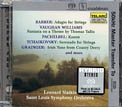|
You are reading the older HTML site
Positive Feedback ISSUE
15
Hi-Res reviews featuring our friends from Audiophile Audition 48 SACD & DVD-A Reviews this month in AUDIOPHILE AUDITION. Here is a sampling of 16 of them including our Multichannel Disc of the Month. The other three parts of Hi-Res Reviews in our September issue include DVD-As & xrcds of jazz, pop, rock and other genres. With this issue we have added timings and ratings. John Sunier September 2004, Part 1 of 4 - Classical OUR MULTICHANNEL DISC OF THE MONTH
W.A. MOZART: Requiem - Christine Schafer, soprano; Bernarda Fink, alto; Gerald Finley, bass; Kurt Streit, tenor; Arnold Schoenberg Choir/Concentus Musicus Wien/Nikolaus Harnoncourt - Deutsche Harmonia Mundi Multichannel SACD 82876 58705 2, 50:15 - 5 stars Mozart's famed "requiem fragment" knocks me for a loop each time I hear it, but this recording knocked me off my feet and I landed in mid-air. Everything seems right, from the subdued Introitus to the brief but astonishing Dies Irae. Only Verdi's Dies Ira comes close to this one in linking a frightening mood with exciting musical invention. The SACD surround balance is near perfect: you feel that you are in that church trembling away your last moments! Harnoncourt's sense of drama is intense: I have never heard a conductor respect Mozart's rests so well. Fink and Schafer show remarkable restraint and conviction in the Tuba Mirum, and Fink's lower registers are particularly tasty. Harnoncourt conducts the Confutatis with erratic tempos and demonic dynamics, probably to truly confound the damned among us. The Lacrimosa is heart-wrenching, as it should be, and is almost too intense to listen to very often. It is fairly easily to determine where Sussmayr's pen begins. There is an imagination dip at the Sanctus and Benedictus, whose fugal parts could have been accomplished by a lesser musician like Karl Stamitz. However, this stellar ensemble handles even these patch-worked parts like true professionals. The notes mention that this is a revised version by Franz Beyer, who "corrected technical mistakes made by Sussmayr," with no mention of what these mistakes were or even who Beyer is. (He is a violist who's performed with the Melos Quartet.) A nice extra is a Windows CD-ROM program with the original score flitting by as the music plays. It's moderately diverting for a few pages, but a bit hard to read. A better idea would have been to have included a printed score, perhaps on a split screen. A minor quibble for a major performance, whose last notes will shake your bones. Throw away your other versions. They'll never measure up to this one. Peter Bates The Linn SACD with Mackerras which we recently reviewed was excellent, but is a more small-scale version, not benefitting from the excitement of a live recording situation as is this one, and considerably less enveloping in the surround mix..Ed.
TALLIS: Spem In Alium; Lamentations; Mass & Motets - Magnificat/Philip Cave, Director - Linn CKD 233 - Multichannel Hybrid SACD - 3 stars Notes in the booklet that accompanies this disc describe Thomas Tallis as the father of English church music; he was the first composer to write music to English liturgical texts, and served under four monarchs, ranging from Henry VIII to Queen Elizabeth I. His longevity was no mean feat, with Tallis being a Catholic in an era when many Catholics were losing their heads (literally)! He was Queen Elizabeth I's favorite composer, and was given (along with Tallis' pupil William Byrd) exclusive license to print and publish music, and Elizabeth obviously must have had a liking for Latin texts, which comprise this collection. I was excited upon receiving this set to hear the disc's centerpiece, Spem In Alium. Unique in early English liturgical music, it was written for forty voices, comprised of eight choirs of five voices each. The picture on the back of the booklet obviously depicts this particular piece being recorded (everything else in the collection is written for anywhere from four to fifteen voices) with the singers arranged in a large circle around the conductor and the microphones; however—darn it—the recording dates from 1997, so it probably was recorded in stereo and remixed to surround. It would have been nice to hear the group recorded in surround as arranged here, with the individual choirs coming at you from all directions. Oh, well, hopefully direct DSD recording isn't too far in the future. The singing is first rate throughout—with director Philip Cave being a member of the Tallis Scholars, would you expect anything other than deeply-felt, idiomatic performances? All of Tallis' signature pieces are included here, and all are given superb readings. My only complaint is that the recorded sound is a tad flat, but I have to qualify that—I do almost all of my listening in surround sound, and it doesn't have nearly the depth of soundfield I've come to expect from most multichannel choral recordings. Of course, some of the pieces are only written for four or five voices, and one can always fiddle a bit with the knobs to help increase the sense of ambience, but a little more ambience in the mix would have been greatly appreciated. And if most or all of your listening is done in stereo, well, it's a moot point, anyway. If you had to pick one recording of Tallis from the numerous choices out there, you wouldn't go too far wrong by choosing this one. And the CD layer of all Linn SACDs are HDCD encoded, which adds extra appeal to many. Recommended. Tom Gibbs
PALESTRINA: Missarum Liber Primus - Polyphonic Choir of the National Academy of Santa Cecilia/Roberto Gabbiani, Director - Fone 033 - Multichannel Hybrid SACD - 2 stars This 3-disc set of Palestrina masses is my first experience with SACDs from the Italian label Fone. Based on the information provided in the supplied booklet, the set was recorded in DSD via a Pyramix/dcs system, so I was really looking forward to superb sound and already planning to check out other Fone titles—well, maybe not so fast! There are several problems with this set, both from technical and performance standpoints, all of which came as a great disappointment to me. The performances here are really pretty good—but just not quite as idiomatic as I had expected from a choir whose tradition is rooted in the works of Palestrina. The sopranos have a particularly grating "screechy" quality to their intonation, and these works need to be played at a rather loud volume to fully experience the maximum resolution of the recorded acoustic—which, of course, amplifies the problem significantly. I own several other discs of Palestrina masses and motets (among them a particularly stellar performance on the Christophorus label), and none of them exhibit the poor intonation found here. The recording itself is also a bit problematic; while the voices themselves have a fairly palpable character and there's a very good sense of the recorded soundstage, both in width and depth, there's a constant drone that permeates the background of all the pieces. It's an almost electronic buzz, and really much too loud to make the set an acceptably enjoyable listen. Something must have been going on with the electronics, because this is much, much louder than the usual ambient background noise present in most recordings. There's a ton of Palestrina for the buck here, but if you're looking for the final word in performance and transparency, I'd look elsewhere. Tom Gibbs
The Powers of Heaven: Orthodox Music of the 17th & 18th Centuries - Estonian Philharmonic Chamber Choir /Paul Hillier, Director - Harmonia Mundi HMU 807318 - Multichannel Hybrid SACD - 5 stars In their outstanding first recording together, choral conductor par excellence Paul Hillier and the Estonian Philharmonic Chamber Choir chose modern liturgical works that traversed several Christian traditions throughout the Baltic region. This, their second disc together, follows a clear succession of strictly Orthodox choral composers from the 17th and 18th centuries, but the results are no less spectacular—forgive me if I pile on the accolades, but this is a drop-dead, gorgeous disc, truly exceptional in every aspect of performance and recorded sound! The Estonian Philharmonic Chamber Choir is, as always, in excellent voice; their singing and vocal intonation is perfect throughout. As usual, there isn't much in the way of information from HM with regards to the source of the original recording, but look deep into the liner notes and you'll see a DSD engineer credited. The recorded sound here is so incredibly open and acoustically transparent—it very well may be coming from a pure DSD recording. I can't say enough good things about this disc—it's a definite must-have, whether for lovers of choral music or just superb recorded sound, in general. Very, very highly recommended. Tom Gibbs
SCHOENBERG: Jacob's Ladder; Friede auf Erden - Berlin Radio Choir with vocal soloists - German Symphony Orchestra, Berlin / Kent Nagano, Conductor - Harmonia Mundi HMC 801821 - Multichannel Hybrid SACD - 4 stars Jacob's Ladder is Arnold Schoenberg's earliest religious-based work, dating from 1917. The oratorio was never completed; Schoenberg's two periods of service in World War I interrupted his compositional process to such an extent that he left the work as a fragment, and subsequent attempts to revise the piece even as late as 1944 were fruitless. After Schoenberg's death, a former pupil scored the work and prepared it for performance at the request of his widow. The accompanying piece, Friede auf Erden (Peace on Earth), is presented in both instrumental and choral forms which frame the oratorio. The instrumental version that opens the disc is almost eerily tranquil, and bears little resemblance to Schoenberg's canon of works from the Second Viennese School. Within a few bars of the opening of Jacob's Ladder, you return to much more familiar musical territory stylistically. The juxtaposition of the orchestration and vocal soloists is quite jarring at times, and makes for quite a challenging listen—newbies to Schoenberg's work will probably find this listen extremely tough sledding. Many rewards are to be found within, so persevere—the wordless chorus of the Soul, for example, is quite striking and otherworldly in its serenity. The disc's sound, as with other recent SACD releases from Harmonia Mundi, is top-notch. There's no information concerning the source of the recording (probably PCM); however, the surround mix is superb, and offers an extremely natural soundstage. Kent Nagano and Harmonia Mundi are to be commended for their recent choices in repertory; by bringing us performances of infrequently-heard and challenging pieces such as Schoenberg's Jacob's Ladder, they've helped educate us and enrich our musical experiences. Highly recommended. Tom Gibbs
BACH: Organ Works Played on the Great Silbermann Organ in Freiberg Cathedral - Gisbert Schneider, Organ - Cybele SACD 030.202 - Multichannel Hybrid SACD - 4 stars Gottfried Silbermann was a master organ builder and contemporary of J.S. Bach, and there's a good deal of documentation that suggests Bach may have even offered consultation to Silbermann on the overall sound character of his various organs. The instrument employed in this recording is housed in the Frieberg Cathedral in Saxony, and is the oldest surviving Silbermann organ, dating from 1714. A major restoration on the organ was completed in 1983. The organist, Gisbert Schneider, obviously has a great affinity for the works of Bach, and plays with an exceptional level of virtuosity. The instrument is in excellent voice, and Mr. Schneider expertly renders not only the full-tilt bravura found in so much of Bach's work, but also the subtle nuances—listen, for example, to the delicate keystrokes of the Choral Partita or the Passacaglia—both played with breathtaking beauty. Cybele has given us another outstanding recording here, and even though it sources from a 24/48 PCM tape transferred to DSD, the sound is superbly full-bodied and transparent. The multichannel layer, which I spent most of my time listening to, is a textbook example of how SACD should be done, and captures the acoustic of the cathedral vividly. A superb recording, and very highly recommended! Tom Gibbs
VORISEK: Chamber Music (Violin Sonata Op. 5. Rondo Op. 6 for violin and piano. Variations Op. 9 for cello and piano. Rondo Op. 11 for string quartet) - Ivan Klánsky, Kocian Quartet - Praga Digitals PRD/SACD 250 204 (60 mins.) - 4 stars Jan Vaclav Hugo Vorisek (1791-1825) was a child prodigy of the keyboard, played Mozart concertos in public when he was twelve, studied with Vaclav Tomasek (who would influence Schubert, Schumann and Dvorak) and had a brief career as a composer of affecting, occasionally flashy music tinged with early Romantic overtones. This new program from the Kocian Quartet and pianist Ivan Klánsky, aided by a subtly magnificent SACD recording, explores the considerable accomplishments of this very mellifluous composer. The most beautiful and haunting is the first movement of the Violin Sonata: When the Allegro moderato kicks in after a short, slow introduction, the grace and beauty of the thought is something Beethoven of the Opus 96 Violin Sonata would have been proud of. The Scherzo, which comes next, is full of exceptional, stormy touches, and the Trio is a lovely counterpoint. The gypsy spirit of the Finale is exhilarating. Neither the two Rondos nor the cello variations provide anything quite so original, but listening to the first-class performances by the top Czech musicians, captured in gorgeous sound, you can imagine the impact Vorisek made on contemporary audiences. Recorded in the Domovina Studio in Prague, the DSD sound is distinguished in both conventional CD and SACD playback, the latter adding a touch of luminosity to what is already a recording enhanced by precisely judged resonance. The multichannel sound is particularly spectacular in the variations where the rich sound of the cello is set off perfectly by the radiant piano. The recording's excellence is probably a blessing as well as a curse, for with two-channel CD sound being already so good it makes championing the new format more difficult. [But it's not a bit difficult if you are comparing to the multichannel version - which you don't have with standard CD!...Ed] Still, the clearly audible benefits will delight both audiophiles and music lovers alike. Laurence Vittes
BEETHOVEN: String Quartet No. 13 in B-flat Major, Op. 130 with Grosse Fuge, Op. 133 and alternative finale - Prazak Quartet - Praga PRD/SACD 250 206 55:22 (Distrib. Harmonia Mundi) - 4 stars This stunning multichannel performance of Beethoven’s Op. 130 was recorded between November 25-December 11, 2003 in the Domovina Studio, Prague. It represents volume 7 of the complete Beethoven Quartets cycle and it continues the vision instilled in these Bohemian musicians by Antonin Kohout, cellist of the Smetana Quartet, who tutored their conceptions. As a former student at SUNY Binghamton in the late 1960s, when the Guarneri Quartet was in residence, I often sat in on their rehearsals of the late Beethoven quartets where each of the players expressed his concern, nay fear, of these monumental works. “They are so dense and intense,” quoth Michael Tree. Certainly, in its own time (1825) Beethoven’s original conception with its six movements concluding with the Great Fugue, proved overpowering to contemporary audiences. “Babylonian chaos” the critic of the Leipzig Musical Times called it (1826). Today, we hear the echoes of the Mozart divertimento form, refined through Beethoven’s mastery of the church chorale, keyboard variations, and the vocal recitative he had found useful in the Ninth Symphony. I find the Prazak approach to Beethoven’s knotty but refreshing intricacy direct and polished, rather aggressive in its confidence. Besides the solemnity that often hinders renditions of Op. 130, there are moments of rustic humor, as in the 6/4 country dance that interrupts the second movement. Schumann called the Andante con moto a “profound intermezzo” in the course of the quartet’s spiritual journey, a pensive fantasy in triplets and chromatic runs marked by moments of disturbing undercurrents. Haydn then makes his presence known in the Allegro assai, and the Prazak play with a detache that adds a bit of sardonic bite to the German dance. While the playing of the Great Fugue is compelling, I still favor my original impression this work made on me via the Koeckert Quartet back in 1957. Rather, the inclusion of Beethoven’s B-flat alternative, with its Slavic A-flat second theme, seems the more successful conclusion under the Prazak ensemble. It could be that the hard-won resolution of the epic Fugue is sometimes more emotional input than I can sometimes bear. Gary Lemco
BRAHMS: Violin Concerto in D Major; 14 Hungarian Dances - Joseph Swensen, violin and conductor - Scottish Chamber Orchestra - Multichannel SACD - LINN CKD (SACD) 224 72:16 - 3 stars It seems violin virtuoso Joseph Swensen has taken up the conductor’s baton as well, a phenomenon no less notable in Itzhak Perlman, Joseph Silverstein, and Pinchas Zukerman. The Linn label offers a number of discs, from Mendelssohn to Mozart to Sibelius, each featuring Swensen leading the Scottish Chamber Orchestra, a post he has held since 1996. The Linn label prides itself on audio fidelity, and this disc is recorded with great clarity and good balance in both the stereo and multichannel options. Playing a 1715 Stradivarius lent him by a patron of the Scottish Chamber Orchestra, Swensen makes lovely sounds in the familiar Brahms Concerto, cadenza by Joachim. As for the conducting, it is somewhat episodic in phraseology, as though the Brahms could be approached periodically, in the manner of Bruckner. That Swensen likes to linger over a melting phrase or sequence, along with oboe, flute, horn, or string accompaniment, makes for pretty intertwinings. Nice oboe by Robin Williams in the Adagio. When I saw that the disc is filled out with Hungarian Dances, I thought the arrangements would be for violin and orchestra, a kind of homage a Remenyi. No, they are straight orchestral renderings, with the four-hand piano transcriptions by Schmeling, Gal, and Dvorak, et al., including the three which Brahms orchestrated himself. Didn’t I first hear some of these with Schmidt-Isserstedt on an old Richmond LP? They are still colorful, semi-gypsy fun. Gary Lemco
SHOSTAKOVICH: Symphony No. 5 in D Minor; Symphony No. 9 in E Flat Major - Kirov Orchestra, Marinsky Theatre, St. Petersburg/Valery Gergiev - Philips Multichannel SACD 470 651-2 - 3 stars Gergiev has been turning out such passionate and exciting performances of Russian repertory that I expected he would bowl me over with the super-dramatic and powerful wartime Fifth of Shostakovich. And especially due to this album having been recorded during a live concert performance with the added stimulus of that environment. Truth is he didn’t even come close to Leonard Bernstein’s white-hot interpretation, never mind that the SACD is in enveloping surround and free of the distortion of the old Columbia recording (in spite of being mastered from only 48K sampling rate PCM rather than original DSD). The composer reverted to a greatly simplified and more direct style here, trying to be a good Soviet composer as pressured by the regime. Gergiev even makes the false optimism of the finale sound like the real thing, whereas Bernstein purposely overdoes it so that, as the composer himself put it, “it’s as if someone were beating you with a stick and saying ‘Your business is rejoicing, your business is rejoicing...’” Even the bass drum whacks are not nearly as jarring, though the sound is cleaner and deeper. The Ninth seems to have more life than the Fifth and is a wonderful treatment of this genuinely good-natured and lighter symphony. John Sunier
MUSSORGSKY-RAVEL: Pictures at an Exhibition; Night on Bare Mountain (two versions); Hopak; Golitsin’s Exile - National Symphony orchestra of Ukraine/Theodore Kuchar - Naxos Multichannel SACD 6.110061 - 4 stars Oh hum, another Pictures in surround. But a very good one with some interesting fillers. Not quite the snap of the recent Gergiev version on Philips SACD or the warm ambience of the classical Slatkin version on Mobile Fidelity SACD, but both of those are just 4.0 channel and this new one is a full 5.1. The Russian orchestra is clearly quite familiar with the music and gives each picture a thorough inspection instead of just throwing off the notes. The notes say it was mastered in DSD but I don’t think that means the original recording - which was probably PCM. Regardless, the multichannel sonics are better than most of the Naxos DVD-As. The other two SACDs just gave us one version of Night on Bare Mountain but here we get two. The original is two minutes longer than Rimsky-Korsakov’s popular transcription, and though it lacks some of that composer’s noted orchestral colors it sounds somehow fresher, more goulish and also more like other Mussorgsky works. John Sunier
MAHLER: Symphony No. 3 in D Minor; Bach Suite (Arr. by MAHLER) - Petra Lang, mezzo; Prague Philharmonic Choir; Netherlands Children’s Choir/Royal Concertgebouw Orchestra/Riccardo Chailly - Decca Multichannel Hybrid SACD 470 652-2 (2 discs) 119 minutes - 3 1/2 stars Andrew Cornall was the executive and recording producer for this latest entry in the Chailly perusal of all the Mahler symphonies on SACD with the Concertgegouw. There is a credit for the SACD surround mix but no mention of the original recording media; I believe it was probably PCM rather than DSD, and this series will probably also eventually be issued as part of Decca’s DVD-A series. With the large orchestra and combined choirs this is a natural choice for surround reproduction, which Vanguard has discovered in the early 70s with their open reel quad tape and SQ discs of the Third with Abravanel (also now available on SACD). The wonders of nature and the power of love seem to be Mahler’s themes in this typically sprawling work. The mezzo’s voice soaring over the combined choir background in the fourth and fifth movements is truly ecstatic. Both performances and recording are impeccable, but I must lean more heavily toward the earlier Third SACD set from Michael Tilson Thomas and the San Francisco Symphony. I find it has more drama, emotional wallop and a particular quality I can only define as electricity. It also comes with the complete Kindertotenlieder, a major Mahler work, whereas Chailly has chosen Mahler’s now-seriously-dated “arrangement” of a few movements lifted from Bach’s Third and Fourth Orchestral Suites. This was before the advent of scholarly Baroque performing standards, and as a result the arrangement sounds like one of those Stokowski Hollywoodized Bach transcriptions. In fact at its premiere Mahler played the continuo part himself on a piano “prepared” to sound something like a harpsichord. John Sunier
ASTOR PIAZZOLLA: Le Grand Tango; Celos; Tres Tangos; Close Your Eyes and Listen; Tango No.1; Tango No. 2 - Orchestra da Camera Italiana/Salvatore Accardo - Fone Multichannel Hybrid SACD 021 SACD 51 minutes - 4 stars I’ve been a Piazzolla aficionado since hearing the first note of his Libertango many years ago, and even was fortunate enough to have at one point been in the front row hearing him perform. This interest even stimulated me to take some ill-advised tango lessons. For one thing dancing is not my thing, and secondly Piazzolla’s music is for listening - I don’t know any tango teachers who use it because the rhythms are too irregular. I found this , as well as the two earlier Piazzolla SACDs from Accardo, to be among the freshest and most listenable alternate versions of his music usually heard in ensembles featuring multiple bandoneons. The Argentine composer and the Italian violinist met first in l969 and Piazzolla immediately wrote a Milonga in D for violin and piano for him. Francesco Fiore did the superb transcriptions of Piazzolla’s music for the Camera Italiana. He spoke of the challenges of recreating the special atmosphere and spirit of Piazzolla’s unique music for bandoneon, piano, and guitars into what is basically a string orchestra. He reported the piano part of the title selection - the 12-minute Le Grand Tango - to be the most problematic to translate to strings only. Well, he succeeded grandly and with Fone’s high standards of recording quality (recorded and edited as an entirely DSD production) the music is presented as a compelling Italian string orchestra alternate to the more South American folk style of the originals. John Sunier
DVORAK: Symphony No. 9 “From the New World” (Piano Duet Version); SMETANA: The Moldau - Prague Piano Duo (Zdenka and Martin Hrsel) - Praga Digitals multichannel SACD PRD/DSD 250 189 53:32 - 4 stars It was customary in the 19th century to popularize symphonies and other orchestral works by publishing piano four hand transcriptions of them. Often this was left to the composer of a work to do himself, and that is what Dvorak did with his famous symphony. It’s often surprising how much of the feeling of the orchestral original is transmitted in such transcriptions, and this one presents the war horse work in a fresh new light that is captivating to hear. In fact it sounds as if it would be great fun to play with another pianist. The lack of orchestral color is not really missed, and development of the various themes seems to be more clearly followed and appreciated. The lighthearted Scherzo movement is especially bouncy and ear-catching. Smetana also penned his own four hand arrangement of one of the movements of his vast Ma Vlast symphonic cycle - the most famous one which describes the route of the major river which flows thru Prague. The piano is centered up front but the feeling of the hall is much stronger with the multichannel option than the two-channel, as expected. John Sunier More stereo SACD reissues from Telarc’s catalog of Soundstream-mastered digital recordings...
HOLST: Suites No. 1 in E-flat & No. 2 in F; HANDEL: Music for the Royal Fireworks; Vaughan Williams: Folk Song Suite; GRAINGER: Lincolnshire Posy; plus Marches and Fanfares by Sousa, Arnaud, King & Johann Strauss - The Cleveland Symphony Winds/Frederick Fennell - Telarc Stereo SACD from 50K Soundstream masters - SACD-60639 75 minutes - 4 stars When Telarc first started in business they issued direct discs. Their first digital recordings used Dr. Thomas Stockham’s Soundstream recording system which is based on a 50K sampling rate and has a frequency response up to 25K plus increased detail. That was fine for transfer to LPs, but when CDs came on the scene in l983 they had to convert the 50K signal to the 44.1K of Red Book compact disc, causing a loss in quality due part to the complex mathematical conversion required. Now with the over 100K frequency response of DSD technology they are remastering these classic Soundstream tapes for stereo SACD, and thereby eliminating the artifacts caused by the difficult conversion process. With improved conversion processes (similar to super-bit-mapping) the CD layer on these hybrid discs is said to be improved over the original CDs. The first half of this program was Telarc’s cover version of the popular Mercury Living Presence album of Holst and Handel works with the Eastman-Rochester Winds. It benefitted from cleaner sonics and certainly more emphatic bass drum reproduction. I first compared the original CD with the CD layer on the SACD. Must admit I couldn’t identify a difference. The 44.1 sonics are smashing - with great depth, a wide soundstage, and plenty of impact. It seems almost impossible to imagine much could be improved in a two-channel recording over what we’re hearing here. On to the SACD layer: Well, it can. The Chaconne beginning the first suite opens with fairly soft brass. Though still soft on the SACD it now has more of a brassy quality about it. The snare drum that follows it has more snap than on the CD layer. In the next movement - the Intermezzo - woodwinds take over. Their particular timbres all sound more “woodwindy” - if you’ll pardon the expression - on the SACD vs. the CD layer. The seven Percy Grainger selections, some of which folk melodies will probably sound familiar even to non-Brits and Aussies, are marvelous wind band pieces, and Fennell’s version of The Stars and Stripes Forever will make any audiophile stand up and salute. John Sunier
BARBER: Adagio for Strings; VAUGHAN WILLIAMS: Fantasia on a Theme by Thomas Tallis; PACHELBEL: Kanon; TCHAIKOVSKY: Serenade for Strings; GRAINGER: Irish Tune from County Derry; FAURE: Pavane - St. Louis Symphony Orchestra/Leonard Slatkin - Telarc SACD from 50K Soundstream masters - SACD-60641 75 minutes - 4 stars This classic early Telarc compilation came out in l983 on both LP and CD. It’s fully the equal of the fine series of Slatkin St. Louis recordings made for the Vox label by Aubort and Nikrenz, but preserved on the digital Soundstream system instead of analog tape. The selections will all be familiar to most collectors and you may in fact have the CD version in your library. The SACD layer definitely clarifies details of the string tone and at the same time reproduces it without the harsh edge of most 44.1 recordings of strings. The original CD not only had less resolution but also less selections on it. John Sunier Be sure to see recording artist David Elias' article this issue of PF "Why Surround Me With All This Sound?" Reviews reprinted with permission from Audiophile Audition
|



